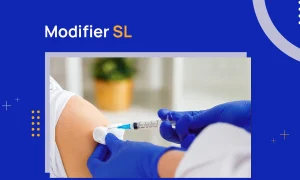Medical billing is an extremely complex process. There are over 11,000 CPT codes, which can confuse even the most experienced billers and coders. However, without proper billing, the entire healthcare and insurance sector will come to a halt.
That’s why it is crucial to understand all the medical billing codes and procedures. Cardiovascular billing is more complicated than usual because it has one of the highest patient inflows and involves critical procedures.
Over 7.1 million echocardiograms are performed annually in the U.S., which makes CPT code 93306 one of the most frequently used codes. Understanding its description, applicable scenarios, modifiers, and billing guidelines is essential for healthcare providers and billing teams.
93306 CPT Code Description
CPT code 93306 is used for a complete transthoracic echocardiogram (TTE) with spectral and color flow Doppler. These are complex terms to understand, so let’s break them down.
The TTE is a non-invasive imaging technique. It uses ultrasound waves to assess the anatomy and function of the heart. This is achieved by capturing 2D images through the chest wall. The following process or medical services are covered under CPT code 93306:
- Evaluation of all four heart chambers (left and right atria, left and right ventricles)
- Examination of heart valves (mitral, tricuspid, aortic, pulmonary)
- Analysis of adjacent aorta and pericardium
- Doppler assessment of intracardiac blood flow and hemodynamics
An important thing to note here is that since this procedure includes both imaging and Doppler analysis, CPT 99306 is used to collect reimbursement for both professional (interpretation) and technical (procedure execution) components.
Appropriate Use Cases for CPT Code 93306
CPT code 93306 can be used to address several different heart structural abnormalities, valve dysfunction, and congenital defects. So, to help you better understand the scenarios in which you can use this code, let’s look at the following key examples:
Suspected Endocarditis
Imagine a patient who visits their doctor with a persistent fever and a newly detected heart murmur. There can be a lot of reasons behind this. However, the doctor suspects that the symptoms could be due to endocarditis, an infection of the heart’s inner lining. This is a severe disease, so the doctor orders an immediate test.
The doctor performs a transthoracic echocardiogram (TTE) with Doppler analysis. While there are other advanced methods to detect vegetation, like using a contrast agent (HCPCS code C8929), the first step is a non-contrast TTE. That’s because it is enough for baseline evaluation and cheaper for the patient. So, the biller will file the insurance claim with CPT code 93306.
Chest Pain Evaluation
Consider a scenario where a patient arrives at the emergency room complaining of chest pain. The doctor thinks this might be due to a heart issue, as numerous symptoms match the description. The doctor orders a TTE with Doppler to evaluate heart function and rule out conditions like pericarditis or cardiomyopathy.
So, in this case, the biller will file the claim with CPT code 93306.
Shortness of Breath Evaluation
Suppose a patient is feeling continuous shortness of breath. He goes to the hospital, and the doctor tests him for all the other causes, like anemia or anxiety, but nothing relates. So, the doctor now has a suspicion of heart failure or pulmonary hypertension.
To test his theory, the cardiologist performs a complete TTE with Doppler and color flow to assess left ventricular function and pulmonary pressures. The CPT code 93306 fits perfectly here because the diagnosis was impossible without getting data on the left heart chamber.
Modifiers to Append with CPT Code 93306
Using the correct code isn’t enough to ensure successful reimbursement. Billers sometimes also have to use proper modifiers to justify the use of CPT codes. The modifier provides additional information about the procedure and helps the insurance providers make fair payment decisions.
The following modifiers are most commonly used with the CPT code 93306:
| Modifier | Description |
|---|---|
| Modifier 26 | Professional Component: The physician only interprets the echocardiogram results. |
| Modifier TC | Technical Component: Billing for the technical execution of the echocardiogram. |
| Modifier 59 | Distinct Procedural Service: The Echocardiogram was separate from other procedures. |
| Modifier 76 | Repeat Procedure by Same Physician: The same provider repeats the echocardiogram. |
| Modifier 77 | Repeat Procedure by Another Physician: A different physician repeats the procedure. |
| Modifier 52 | Reduced Services: The Echocardiogram was partially completed or limited in scope. |
| Modifier 53 | Discontinued Procedure: The procedure was started but discontinued due to unforeseen circumstances. |
Reimbursement Guidelines for CPT Code 93306
Billing CPT code 93306 successfully hinges on precision and compliance. Here’s how to nail it:
Document Everything Thoroughly
Documentation is the backbone of your claim. So, it is essential to include all the relevant documents related to the procedure. The following medical records and documents are required for CPT code 93306:
- Detailed reports related to the condition of heart structures, i.e., ventricles, atria, valves, aorta, and pericardium.
- Measurements from various heart views, with interpretations (normal vs. abnormal findings).
- Hemodynamic and blood flow data.
- Also, make sure to specify confirmation of Doppler and color flow use.
Know Your Payer Policies
Reimbursement rules vary by payer. That’s because each insurance provider has its unique policies. So, the billing guidelines and the final amount you can receive will vary for each payer. The reimbursement rate also varies based on the geographic location and the type of healthcare provider (individual physician offices or hospitals). The rates for each locale are determined by the local Medicare Administrative Contractor (MAC).
For instance, in 2023, CPT code 93306 had the following national and unadjusted payment rates in physician offices:
| CPT Code | Modifier | Reimbursement Amount |
|---|---|---|
| 93306 | TC | $130.47 |
| 93306 | 26 | $68.11 |
So, before filing your claim, verify the specifics with your MAC or payer to avoid underpayment.
Leverage Technology for Accuracy
Do you know that almost 63% of healthcare providers experience insurance underpayments? You can avoid this by using automated billing software. Revenue cycle management tools can help identify discrepancies and ensure correct reimbursement for CPT code 93306.
Use Modifiers Wisely
Unncessarily appending modifiers can trigger denials or audits. Refer to the modifier list above and apply them only when justified.
Excessive use of unnecessary modifiers not only heightens the risk of denials but may also lead to legal repercussions, potentially resulting in financial penalties and reputational harm.
Final Thoughts on CPT Code 93306
CPT code 93306 is one of the most essential cardiology billing codes. After reading this blog, you should have all the necessary information to file a claim successfully with code 93306.
So, what is the takeaway? Precision matters. Detailed documentation, payer awareness, and strategic modifier use can cut denials and boost your bottom line. If you are still overwhelmed by the complexity of billing, contact our billing experts, who have decades of experience in providing cardiology billing services.
FAQs
What is the difference between 93306 and 93307?
93306 includes spectral and color Doppler with 2D imaging. On the contrary, 93307 is 2D imaging only, without spectral and color Doppler.
What documentation is required for 93306?
CPT code 93306 requires a detailed report showing 2D images, M-mode, spectral and color Doppler findings, heart measurements, and physician interpretation.
What is included in 93306?
CPT code 93306 covers a comprehensive 2D echocardiogram with Doppler and color flow, including image acquisition, interpretation, and report.
What is Medicare reimbursement for an echocardiogram?
For 2025, Medicare’s national average reimbursement rate for this code is $240.01, based on the total Relative Value Units (RVUs) and the conversion factor set by the Centers for Medicare & Medicaid Services (CMS). However, this amount is not fixed and varies for different locations. On average, the reimbursement lies between $187 and $252.
Does an echocardiogram require prior authorization with Medicare?
Typically, prior authorization is not necessary for an echocardiogram covered under Medicare Parts A and B. However, certain Medicare Advantage plans might require it.



